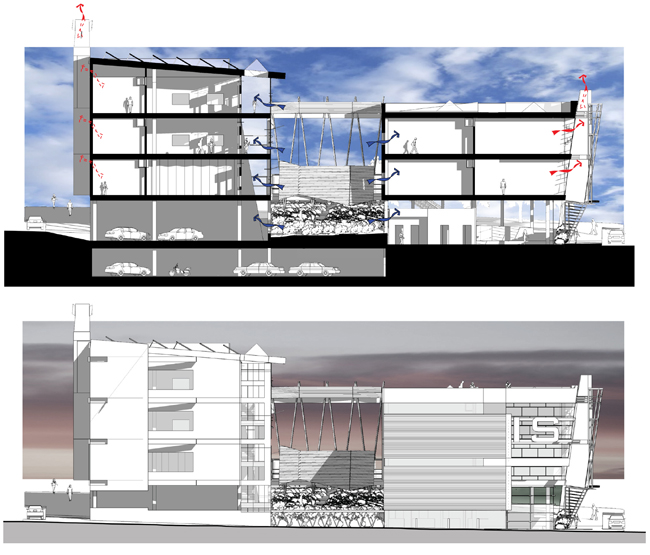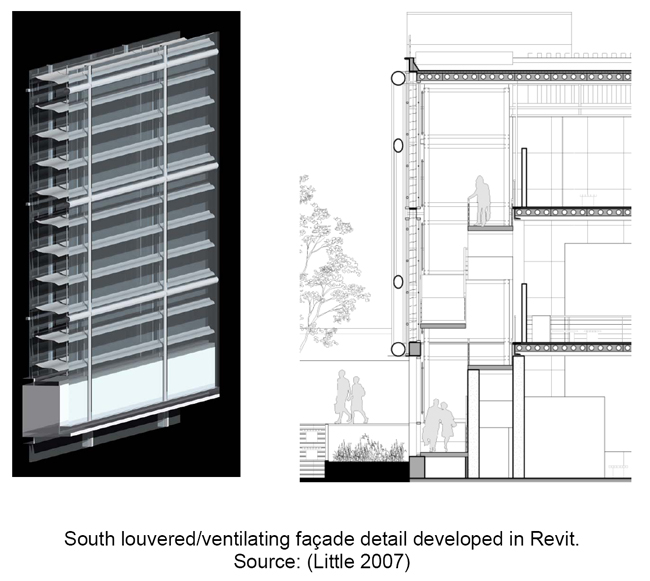Fall 2007 Arch. 451: Architecture Design V (UG) Carbon Neutral Studio
Indoor Air Quality

Design Performance Objective |
Natural Ventilation Diagram
Students create drawings and diagrams which convey their understanding of the routes of air through spaces in their designs. This particular example includes a vegetated core between buildings that generates an edge in-edge out ventilation strategy. Stack effect cross ventilation is employed at a conceptual level demonstrating the basic principle of air buoyancy.
|
Student: Thomas Sharp
|
Software/Tools: |
|
|
Fall 2007 Arch. 451: Architecture Design V (UG) Carbon Neutral Studio
Indoor Air Quality
This topic is complex because it is not directly related to carbon neutrality, but if design is taught well, it is a happy byproduct of the process. Students must be exposed to the importance of fresh air and high levels of indoor air quality as it relates to the health and welfare of users. The mechanisms for achieving this have to do with ventilation strategies including cross and stack ventilation, as well as the design of mechanical systems with adequate air changes. The former can be discussed and resolved in the studio, the later is more of a professional practice and consultant relationships issue. The objective then, for the design studio, is for the students to demonstrate that 1) air can move through the environments they have created without relying on fans, and 2) they understand some of the barriers to designing for fresh air.
|
Investigative Strategy |
The strategy for achieving success in this topic is by creating section drawings with air flow assumptions. In advanced courses, students might use software to confirm assumptions and make adjustments. Again, this is a rules of thumb approach, especially for studios without robust resources for “measuring” airflow. It is enough to demonstrate an understanding of air flow through convection and conduction.
|
Evaluation Process/Criteria |
The basic evaluation criteria is confirming supply and exhaust apertures of sizes that are appropriate to the scale of the space, providing routes for air to move through adjoining spaces, avoiding polluted airs from moving through adjoining spaces, and demonstrating all of these with section drawings (or three-dimensional representations). |
|
Information about the Project and Studio |
• course outline
• project outline |
Cautions/Possible Confusions |
“One doesn’t achieve natural ventilation by simply sticking stacks on the tops of their buildings” one colleague commented recently. Students must understand that air flows like fluid flowing through a conduit. If students can imagine and design flow-conduits that move through their designs, they can demonstrate some understanding of fresh air movement, and thereby create opportunities for increased IAQ.”
|
Range of Applicability in terms of CLIMATE |
|
Range of Applicability in terms of TYPE |
|
Reference Material |
Building for Life, Stephen Kellert, Island Press, 2005, ISBN 1-55963-721-8, Lomas, K. 2007. Architectural design of an advanced naturally ventilated building form. Publisher: Energy and Buildings. Lomas, K., Cook, M., Fiala, D., 2007. Low energy architecture for a severe US climate: Design and evaluation of a hybrid ventilation strategy. Publisher: Energy and Buildings. Short, C.A., Lomas, K. 2007. Exploiting a hybrid environmental design strategy in a US continental climate. Publisher: Building Research & Information. |
Duration of Exercise |
Part of a semester long design studio. I only teach semester long design studios (or two semester long projects). I never teach short “sketch” projects, because they reinforce the idea that you can just breeze in and out of design without any long term responsibility. If a project is a “sketch” problem, it is always tied to a larger relevance in a future project. |
Degree of Difficulty / Previous Knowledge Required |
Remarkably easy and remarkably hard. To do abstractly a freshman can do this. Freshmen can abstractly model conduits of form, why not air/fluid flows? Advanced work in ventilation requires a solid foundation of physics. To do accurately a deep knowledge of physics is required. In American schools, this appears to be a severe limitation. |
| |

|
|
|
|

